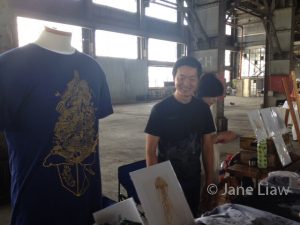More than just shopping at San Francisco’s Urban Air Market
There are some intriguing abandoned buildings in my neighborhood–looming old warehouses and factories with broken windows and a falling-down appearance. Despite the disrepair, there’s still a trace of majesty to their hulk that make it easy to imagine them in their glory days, full of workers and noisy machinery—fixing the ships, producing the mining equipment, constructing the San Francisco cable cars of the 19th and early 20th centuries.

I take walks on the roads between the buildings and try to peek in the windows, curious about what’s left in those massive spaces (I’ve heard some have become underground artist dens). On a recent August afternoon, though, I got to spend some time in one of the buildings that is usually off-limits to the public.
The Urban Air Market, a design market featuring sustainable local goods, was held for the first time in a Pier 70 building once housing a rolling mill that rolled out metal sheets to be used in shipbuilding. Pier 70, a historic pier and collection of buildings belonging to the Port of San Francisco, is slated for redevelopment; those of us attending the Market got a glimpse into this usually private world.
There was a hive of activity at the Market even outside the building, with food trucks, a packed beer garden, and trailers housing clothing and accessory stores. The interior of the building was cavernous, and on this (rare) hot day in San Francisco, walking around the cool interior filled with rows of independent vendors was a welcome respite.
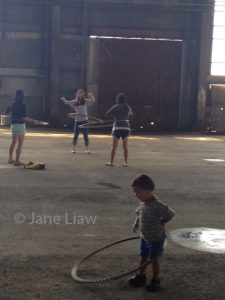
I wandered between stalls selling pillow cases, handcrafted jewelry, wooden furniture, Dogpatch-made toys and more. Many had goods that invited touching, that I lingered over. There’s something about shopping for a product made by the person in front of you that creates a deeper connection to that product and to the whole transaction.
People continually streamed in, along with many kids and all kinds of dogs (it’s not a Dogpatch event without dogs). The building easily accommodated them all. In fact, with grounds so spacious, the Market had the luxury of including a cozy little lounge area and a large space full of hula hoops, where kids and adults alike were wiggling their hips in glee. Near the entrance, musicians played for those sprawled on throw pillows and rugs.
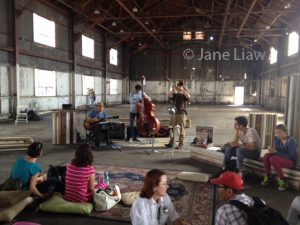
At both ends of the building were displays not usually found at a design market—one delving into the area’s shipbuilding history, the other manned by a representative from Forest City, the development company in charge of the rejuvenating Pier 70 Waterfront Project, to answer questions as visitors looked over photos and descriptions of the various Pier 70 buildings, their history and future plans.
The Urban Air Market has been around for a few years, held in other SF locations. Organizer Danielle Cohen says this inaugural Dogpatch Market attracted a much larger range of visitors: from the usual Market crowd there to shop, to people interested in the history of the site, to Dogpatch neighbors concerned about what their neighborhood would one day look like.
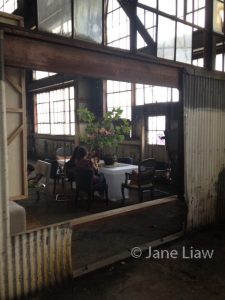
“It’s great that Pier 70 was there and giving tours and informing neighbors,” Cohen says. “This was a huge experiment both for me and for Forest City. The Port Authority has never allowed people on this land before.”
One vendor, Roger Ngu, started his business Studiooiduts selling handdrawn graphic apparel just a year-and-a-half ago, but has already participated in six Urban Air Markets. He was skeptical at first about the new “out of the way” Dogpatch location, but the event turned out to be “surprisingly amazing,” giving him his best event sales ever.
“I think it’s awesome,” Ngu says of Pier 70. “I love that industrial, old school feel and it goes hand-in-hand with our stuff.”
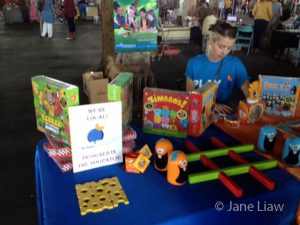
As a visitor, I really liked the Dogpatch site too, and the fact that Cohen had set up the space to be one where we could go beyond shopping, where we could bring kids and pets and while away an afternoon. The lines for the food trucks were long (long enough to deter me from getting anything) and the beer garden was crowded; if I had been hungry, I would have gotten cranky. Cohen noted this too—the high attendance had caught her by surprise, but after all, this was “a good problem to have.” Next time around, she and the food vendors will be prepared for the large numbers.
Overall, I thought the relaxed atmosphere and the melding of commerce with neighborhood interests were a perfect fit for this special location. I hope Cohen brings her event back to Pier 70 soon—it’s just the kind of community event our neighborhood needs.
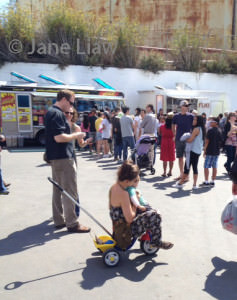
Urban Air Markets are held several times a year in several San Francisco locations, and dates for upcoming events can be found on their website.
